In the modern creative process, the gap between a brilliant idea and a polished final product is often filled by communication breakdowns and disjointed feedback. Juggling multiple file versions, deciphering vague email comments, and struggling to keep everyone on the same page can derail even the most promising projects. This is precisely the problem that dedicated creative collaboration tools are designed to solve. They provide a centralized hub where teams can ideate, design, review, and approve work seamlessly, transforming chaotic workflows into streamlined, productive systems.
This comprehensive guide is built to help you navigate the crowded market of creative platforms and find the perfect fit for your specific needs. Whether you're a freelance designer seeking a better way to share mockups, a marketing team coordinating a multi-channel campaign, or a creative agency managing complex client projects, the right tool can fundamentally change how your team operates. We move beyond generic feature lists to provide a detailed analysis of the industry's top solutions.
Inside, you'll find an in-depth look at 12 leading platforms, including Miro, Figma, Canva, and Adobe Creative Cloud. For each tool, we offer:
- Practical use-case scenarios to illustrate how it performs in real-world situations.
- An honest assessment of its pros and cons, including potential limitations.
- Detailed feature breakdowns that highlight what makes each platform unique.
- Clear pricing information to help you budget effectively.
We've included screenshots for a visual reference and direct links to each website, so you can start exploring immediately. Our goal is to equip you with the insights needed to make a confident, informed decision and select the creative collaboration tool that will empower your team to do its best work.
1. AI Media Studio
AI Media Studio solidifies its position as a standout choice by merging AI-powered content generation with essential team-based workflows. It provides a centralized hub where creative teams can conceptualize, generate, and refine visual assets without the friction of disparate tools. This platform is particularly effective for marketing agencies, content creators, and businesses that require a high volume of unique visuals while maintaining brand consistency across projects.
The platform's strength lies in its intuitive design, which empowers non-designers to produce professional-quality images and videos from simple text prompts. With over 50 distinct art styles, teams can instantly pivot from photorealistic marketing images to animated social media clips, ensuring creative alignment without needing specialized software skills. This accessibility democratizes the creative process, allowing strategists, copywriters, and project managers to contribute directly to visual asset creation.
Key Features & Use Cases
- Shared Workspaces: Create dedicated project spaces where team members can view, comment on, and iterate upon AI-generated visuals. This is ideal for campaign development, where stakeholders need to approve assets in a unified environment. Learn more about AI Media Studio's collaborative features.
- Prompt History & Iteration: Access a shared history of prompts and generated outputs, allowing team members to build upon successful ideas or refine previous concepts. This feature is invaluable for A/B testing ad creatives or evolving a brand's visual identity over time.
- Advanced AI Editing: Paid plans unlock powerful tools like inpainting and outpainting, which allow for precise, collaborative edits. A designer can seamlessly remove an unwanted object from an AI-generated image while a marketer provides real-time feedback within the same interface.
- Commercial Use Rights: All paid subscriptions include full commercial rights, simplifying the legal workflow for agencies and businesses that create content for clients or external marketing channels.
Pricing and Access
AI Media Studio operates on a flexible, credit-based model designed to scale with user needs.
| Plan | Key Features | Best For |
|---|---|---|
| Free Tier | 3 free generations/month, watermarked output | Individuals testing the platform's capabilities |
| Paid Plans | Up to unlimited credits, commercial license, advanced editing, no watermark | Professionals, teams, and high-volume creators |
Pros and Cons
Pros:
- Extremely user-friendly interface requires no technical expertise.
- Over 50 diverse AI art styles for versatile content creation.
- Scalable pricing with a functional free tier and no subscription traps.
- Integrated collaboration features within a unified workspace.
Cons:
- High-resolution output and batch generation are still in development.
- The free plan's three-generation limit is restrictive for active users.
Website: https://ai-media-studio.com
2. Figma
Figma has fundamentally reshaped the landscape of digital design, establishing itself as an indispensable web-based platform for UI/UX professionals. Its core strength lies in its real-time, browser-based collaborative editing, which allows entire teams-designers, developers, and project managers-to work within the same file simultaneously. This eliminates the tedious process of version control and file sharing that plagued older, desktop-based applications. As one of the most powerful creative collaboration tools available, it streamlines the entire design-to-development handoff process.
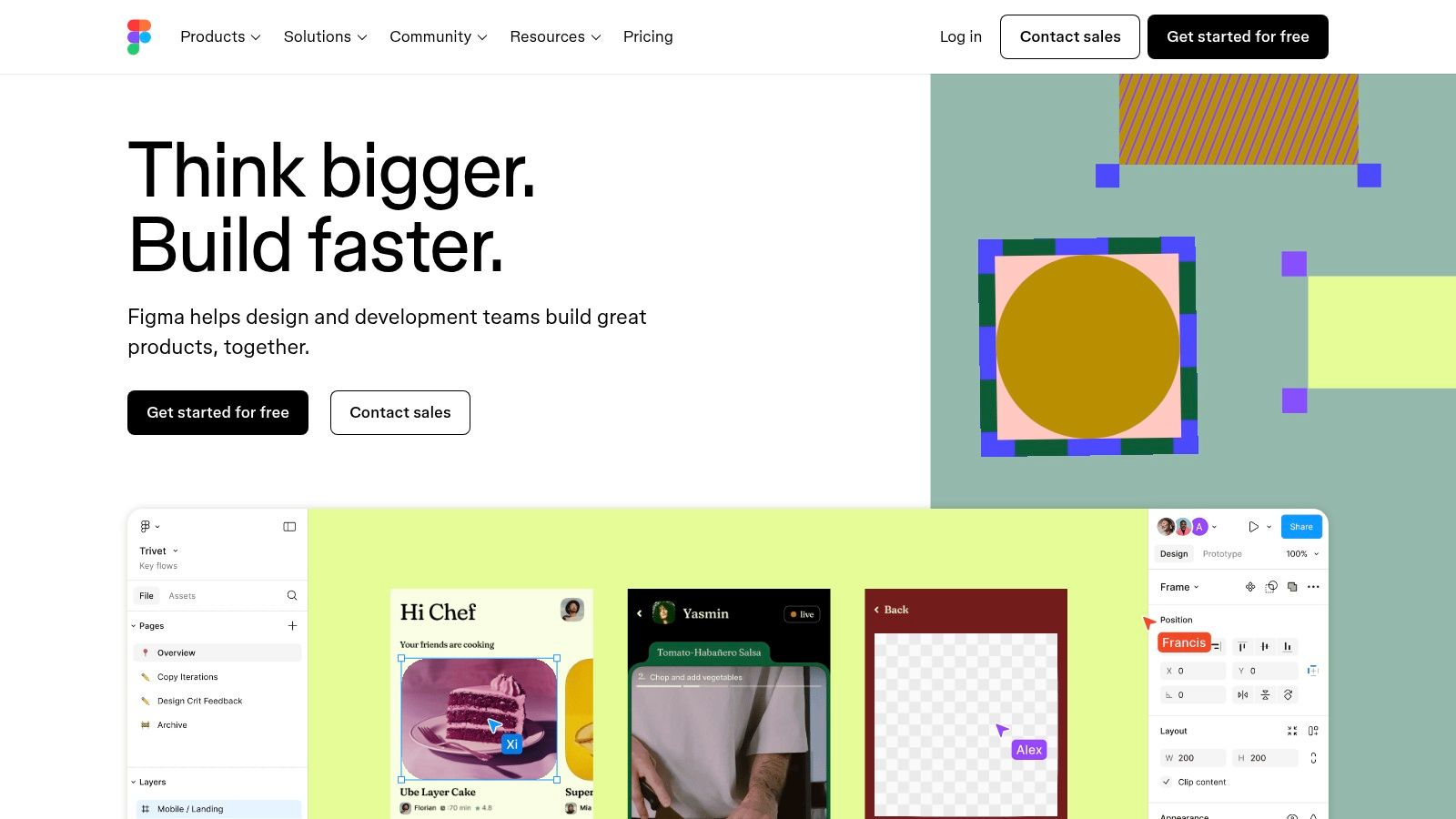
What truly sets Figma apart is its all-in-one ecosystem. Users can move seamlessly from brainstorming and wireframing to creating high-fidelity interactive prototypes without ever leaving the application. This unified workflow is enhanced by an extensive plugin library, allowing teams to customize their environment with tools for everything from accessibility checking to content generation. The cross-platform accessibility means anyone with a browser can view, comment on, or edit designs, breaking down barriers between stakeholders.
Key Considerations
- Best Use Case: Ideal for UI/UX design teams, product development squads, and any group needing to collaborate on visual interfaces and prototypes in real time. It's also excellent for creating social media graphics and presentations.
- User Experience: The interface is clean, intuitive, and widely praised for its user-friendliness, making it accessible even for those new to design software. Performance on extremely complex files with thousands of layers can sometimes lag, however.
- Pricing & Access: Figma offers a generous free "Starter" plan perfect for individuals and small teams. Paid plans like "Professional" ($12 per editor/month) and "Organization" ($45 per editor/month) unlock advanced features like unlimited projects, private plugins, and centralized file management.
- Limitation: The platform's primary weakness is its reliance on an internet connection. While a desktop app exists, its offline functionality is quite limited, making it challenging to work during travel or internet outages.
Website: https://www.figma.com/
3. Canva
Canva has democratized design by making it accessible to everyone, regardless of their technical expertise. It has evolved from a simple graphic creation tool into a robust platform where teams can produce a vast range of visual content, from social media posts and presentations to marketing materials and short videos. Its core appeal lies in its simplicity and speed, powered by a massive library of templates that can be customized in minutes. As one of the most user-friendly creative collaboration tools, it empowers entire marketing, sales, and content teams to contribute to the creative process.
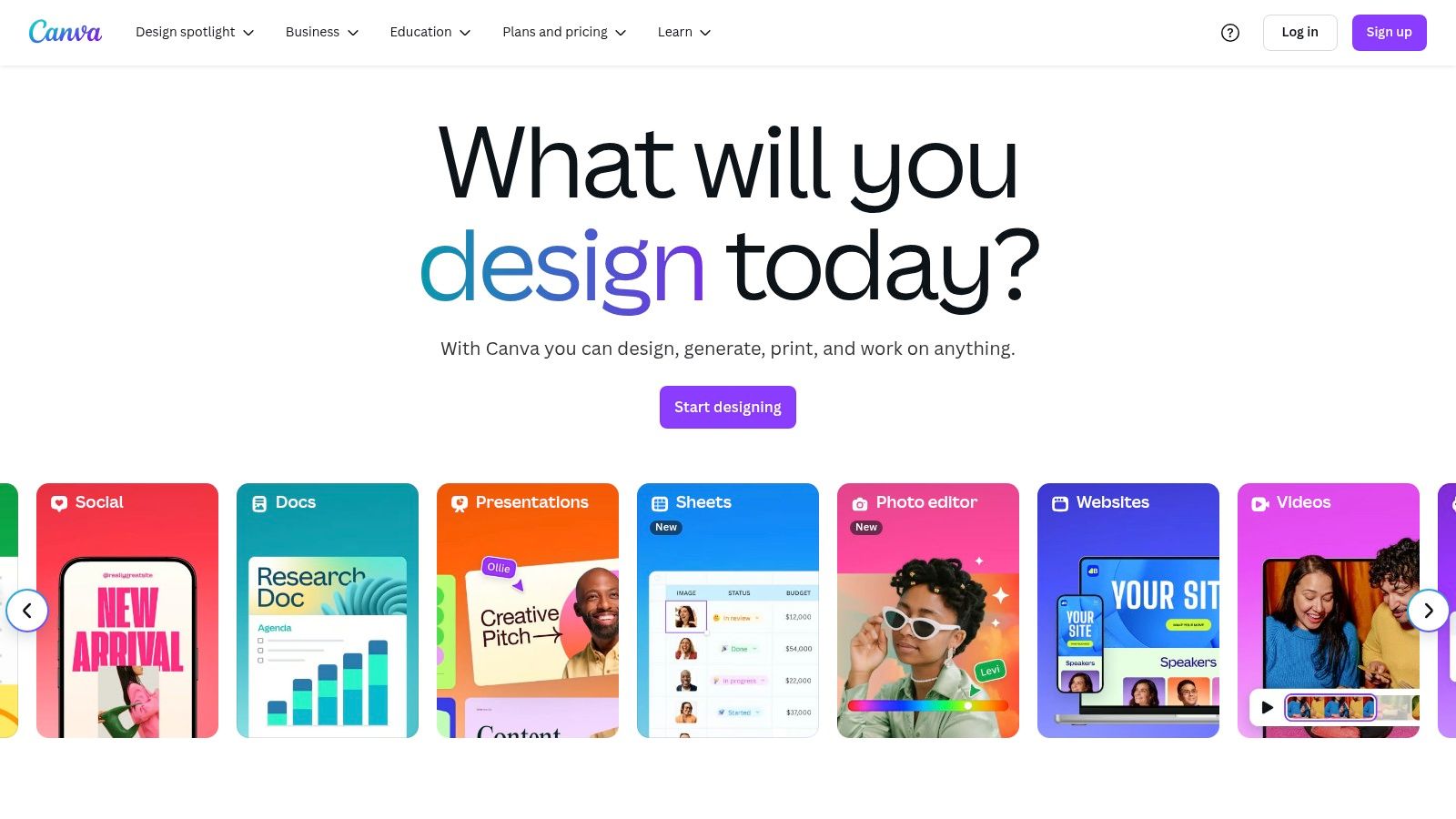
What makes Canva a collaborative powerhouse is its streamlined team functionality. Multiple users can work on the same design in real time, leaving comments and suggestions directly on the canvas. The "Brand Kit" feature is a game-changer for businesses, allowing them to upload logos, color palettes, and fonts to ensure all creations are consistent. This central hub for brand assets prevents the dilution of visual identity and is key to establishing clear visual brand guidelines. This blend of ease-of-use and brand management makes it an indispensable tool for fast-moving teams.
Key Considerations
- Best Use Case: Excellent for marketing teams, social media managers, and small businesses needing to quickly create a high volume of branded content without a dedicated designer. Also popular in education and for creating internal company documents.
- User Experience: The drag-and-drop interface is incredibly intuitive and celebrated for its shallow learning curve. The platform is web-based and highly responsive, making it easy to jump in and start creating immediately.
- Pricing & Access: Canva offers a strong free version with plenty of assets and templates. "Canva Pro" (around $14.99/month for one person) and "Canva for Teams" (starting at $29.99/month for 5 people) unlock premium templates, the Brand Kit, and millions of stock assets.
- Limitation: While powerful for most everyday design tasks, it lacks the advanced vector editing, layer control, and technical precision of professional-grade software like Adobe Illustrator or Figma, making it less suitable for complex illustration or UI/UX work.
Website: https://www.canva.com/
4. Miro
Miro has solidified its position as the quintessential digital whiteboard, transforming how distributed teams visualize and develop ideas. It serves as an infinite canvas where teams can brainstorm, strategize, and manage projects in a highly visual and interactive manner. By providing a shared space for everything from mind maps and user story mapping to retrospective meetings, Miro excels as one of the most flexible creative collaboration tools available. Its power lies in making complex, abstract concepts tangible and accessible to every team member, regardless of their location.
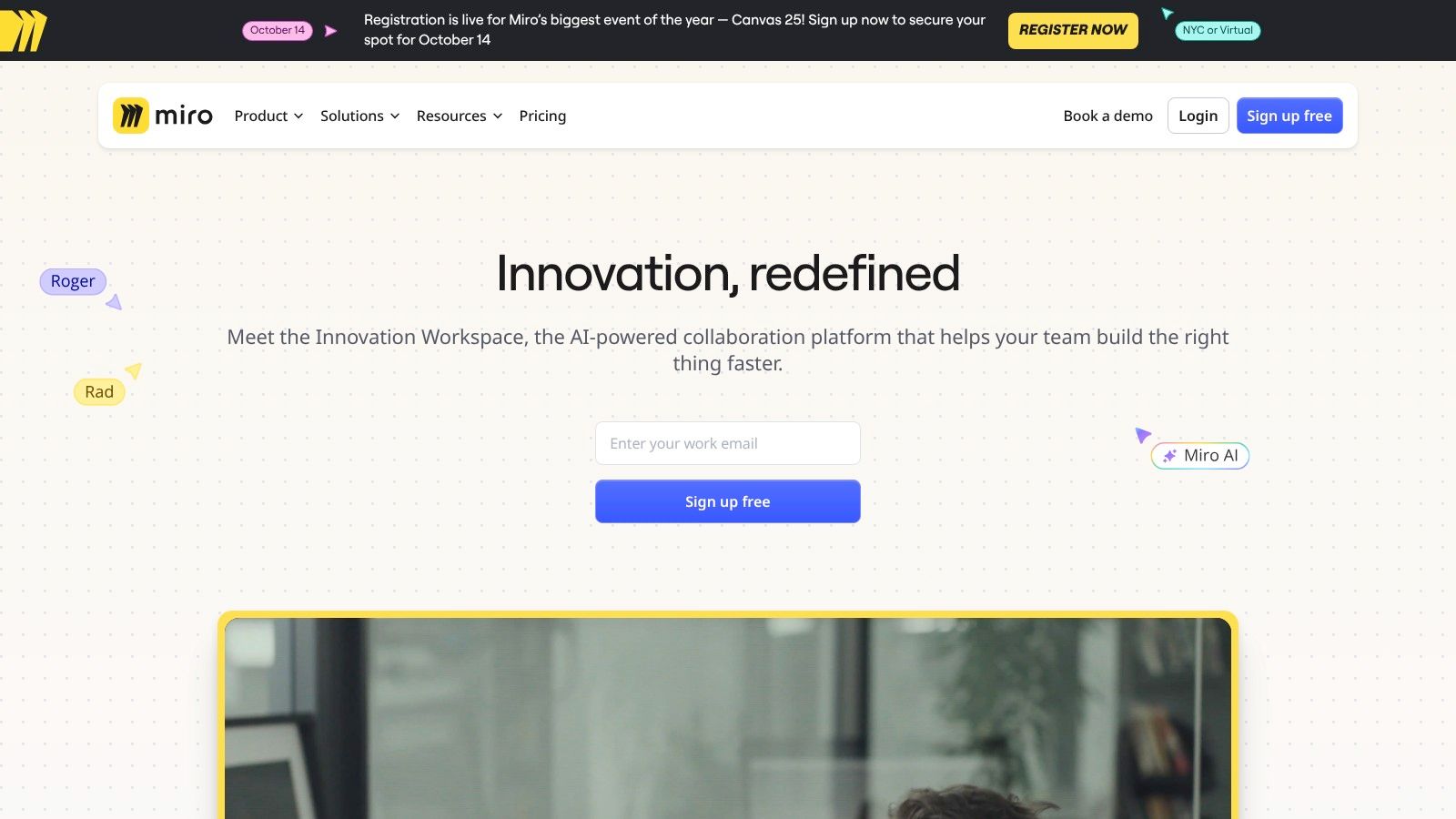
What makes Miro so effective is its ability to replicate and enhance the physical whiteboard experience for remote and hybrid work environments. The platform is packed with an extensive library of pre-built templates for virtually any business or creative process, accelerating workflows significantly. Real-time collaboration is seamless, with features like voting, timers, and integrated video chat that foster engagement and focused work sessions. Its robust integration capabilities with essential apps like Jira, Asana, and Slack ensure it fits neatly into existing team ecosystems, centralizing creative planning and execution.
Key Considerations
- Best Use Case: Perfect for workshops, brainstorming sessions, agile ceremonies (like sprint planning and retrospectives), and visual project planning. It's invaluable for any team needing a shared space to ideate and organize information visually.
- User Experience: While highly powerful, the sheer number of tools and features on the infinite canvas can be overwhelming for first-time users. However, its core functionalities like sticky notes and drawing are intuitive. Performance can sometimes degrade on very large, complex boards with numerous assets.
- Pricing & Access: Miro offers a free plan with three editable boards, making it accessible for individuals or small teams to get started. Paid plans like "Starter" ($8 per member/month) and "Business" ($16 per member/month) offer unlimited boards, private board sharing, and advanced features.
- Limitation: The platform’s greatest strength, its vast feature set, can also be a weakness. Without proper facilitation or team discipline, boards can quickly become cluttered and disorganized, hindering rather than helping collaboration.
Website: https://miro.com/
5. InVision
InVision has long been a cornerstone in the digital product design world, pioneering the interactive prototyping space. It empowers teams to transform static screen designs into fully interactive, clickable prototypes that mimic a real user experience. This focus on high-fidelity prototyping and user feedback makes it one of the most effective creative collaboration tools for validating concepts before a single line of code is written. By enabling designers, developers, and stakeholders to interact with a design, it bridges the communication gap and ensures everyone is aligned on the final product vision.
What distinguishes InVision is its comprehensive suite of tools built around the prototyping core. Features like "Freehand" offer a digital whiteboard for real-time brainstorming and ideation, while its design system manager, "DSM," helps teams maintain brand and UI consistency at scale. The platform also facilitates direct user testing, allowing teams to gather qualitative feedback and heatmaps on their prototypes. This integrated workflow from ideation to validation streamlines the entire design process, centralizing feedback and decision-making in one accessible location.
Key Considerations
- Best Use Case: Excellent for product teams that need to create sophisticated, interactive prototypes for user testing and stakeholder presentations. It's particularly powerful for those looking to manage a centralized design system.
- User Experience: The platform is feature-rich, which can introduce a moderate learning curve for new users. However, its core prototyping functionality is intuitive, and the commenting system is straightforward for non-designers to use.
- Pricing & Access: InVision offers a free plan suitable for individuals and small projects with up to 10 active users and 3 documents. The "Pro" plan ($4 per active user/month) unlocks unlimited documents, while the "Enterprise" plan offers advanced features like DSM and enhanced security.
- Limitation: While once the undisputed leader, newer all-in-one tools that combine design and prototyping in a single application have created strong competition. Its primary function is prototyping and collaboration rather than asset creation itself.
Website: https://www.invisionapp.com/
6. Notion
Notion has carved out a unique space for itself as an all-in-one workspace that transcends traditional categories. It brilliantly merges note-taking, knowledge bases, and project management into a single, highly malleable platform. For creative teams, this means you can build a centralized hub for everything from initial mood boards and brainstorming sessions to detailed project timelines and content calendars. Its block-based editor allows for a fluid combination of text, images, databases, and embedded content, making it one of the most versatile creative collaboration tools for organizing complex projects.
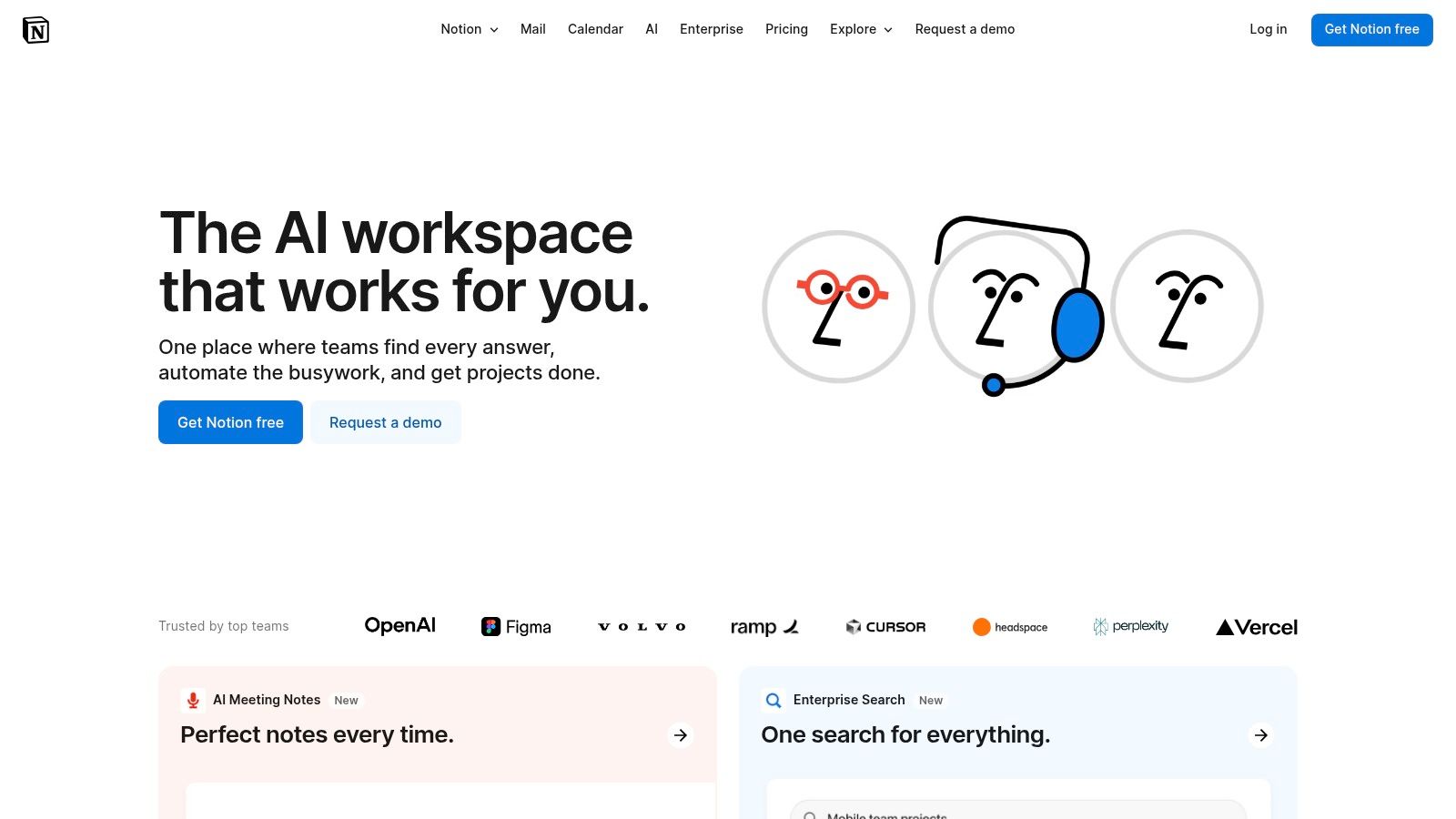
What truly differentiates Notion is its profound customizability. Unlike more rigid tools, it provides the building blocks for teams to design their own workflows from the ground up. You can create interconnected databases for tracking assets, link meeting notes directly to project tasks, and build a public-facing portfolio or help center, all within the same environment. This flexibility allows it to adapt to the specific needs of a creative agency, a solo freelancer, or a large marketing department, ensuring the tool works for you, not the other way around.
Key Considerations
- Best Use Case: Excellent for teams that need a central source of truth for documentation, project management, and planning. It's perfect for building content calendars, managing brand assets, and creating internal wikis.
- User Experience: The interface is clean and minimalist, but its sheer flexibility can present a steep learning curve. New users may feel overwhelmed by the "blank canvas" approach, though extensive community templates help ease this.
- Pricing & Access: Notion offers a robust free plan for individuals. Paid plans include "Plus" ($8 per user/month) for small groups needing unlimited blocks and file uploads, and "Business" ($15 per user/month) with advanced features like SAML SSO and private teamspaces.
- Limitation: The platform's biggest weakness is its dependency on an internet connection, as offline functionality is quite limited and can be unreliable. Its powerful database features can also feel less intuitive than dedicated spreadsheet software for heavy data analysis.
Website: https://www.notion.so/
7. Trello
Trello champions a highly visual and intuitive approach to project management, making it one of the most accessible creative collaboration tools on the market. It utilizes the Kanban methodology, organizing tasks into cards that live on lists within a larger board. This simple "board-list-card" system allows creative teams to visualize workflows, track progress from brainstorming to completion, and easily identify bottlenecks. The drag-and-drop interface lets users re-prioritize tasks in seconds, making it perfect for agile creative projects with shifting deadlines.
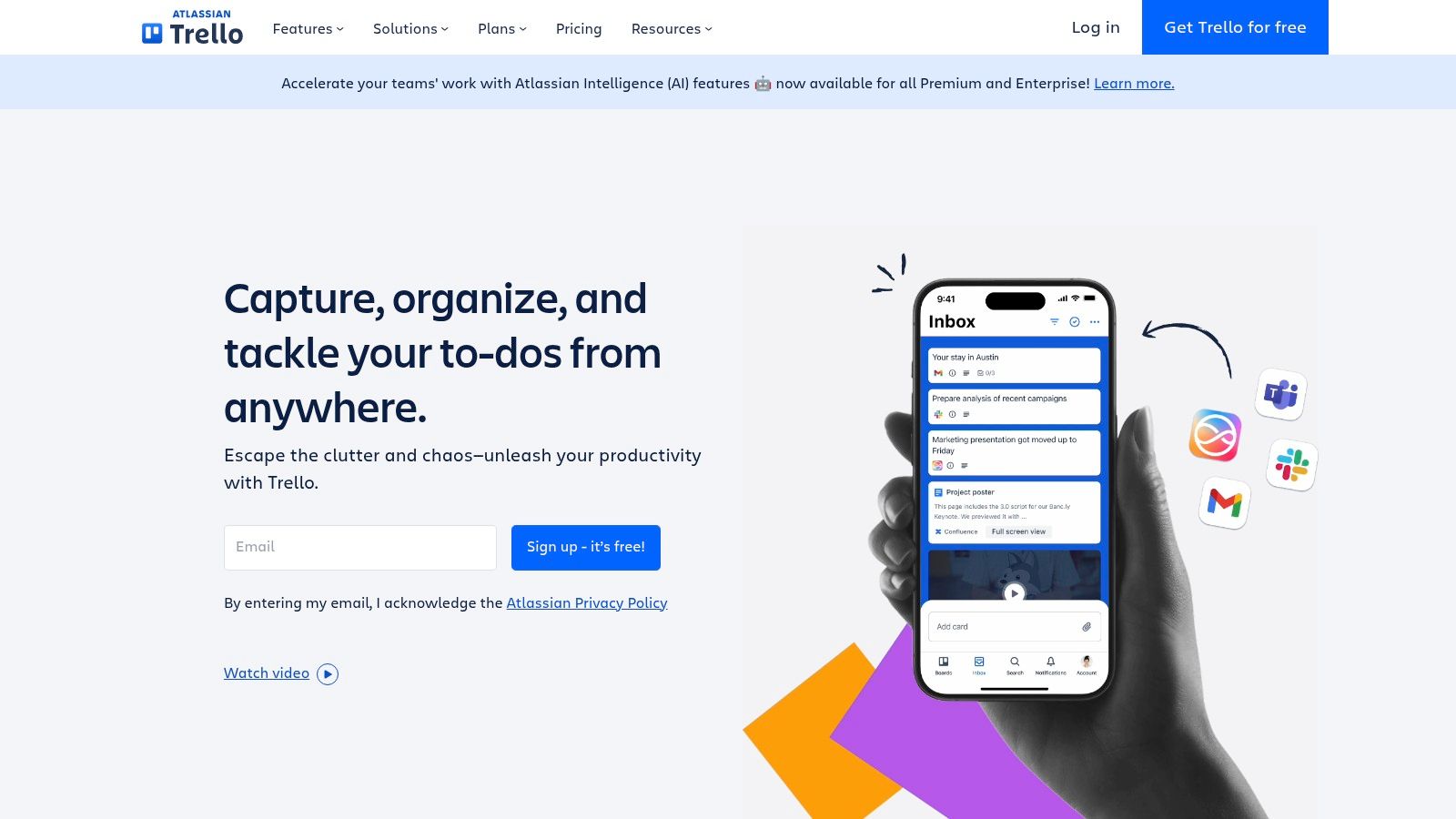
What makes Trello particularly powerful for creatives is its flexibility and integration capabilities. A card can hold checklists, due dates, attachments, and conversations, serving as a central hub for all assets and feedback related to a specific task, like a blog post draft or a graphic design concept. Its "Butler" automation feature can handle repetitive actions, such as moving a card when a checklist is complete, while its extensive library of "Power-Ups" allows for deep integration with apps like Slack, Google Drive, and Figma, connecting disparate parts of the creative ecosystem into one manageable view.
Key Considerations
- Best Use Case: Excellent for managing content calendars, tracking social media campaigns, simple design sprints, and general task management for small to medium-sized creative teams.
- User Experience: The platform is famously easy to set up and use, with a minimal learning curve. Its colorful, card-based interface is clean and engaging, making project management feel less like a chore.
- Pricing & Access: Trello's "Free" plan is incredibly robust for individuals and small teams. Paid plans like "Standard" ($5 per user/month) and "Premium" ($10 per user/month) introduce more advanced features like unlimited boards, different board views (timeline, calendar), and enhanced automation.
- Limitation: While its simplicity is a strength, it can be a weakness for complex projects. Trello lacks advanced project management features like in-depth reporting, Gantt charts, and resource management, which larger agencies or complex productions might require.
Website: https://trello.com/
8. Asana
Asana brings structure and clarity to complex creative workflows, serving as a powerful project management hub rather than a direct content creation tool. Its strength lies in its ability to organize, track, and manage every task from initial concept to final delivery. For creative teams juggling multiple projects, Asana provides a central source of truth, ensuring that deadlines, feedback, and responsibilities are clearly defined and visible to everyone involved, solidifying its place among essential creative collaboration tools.
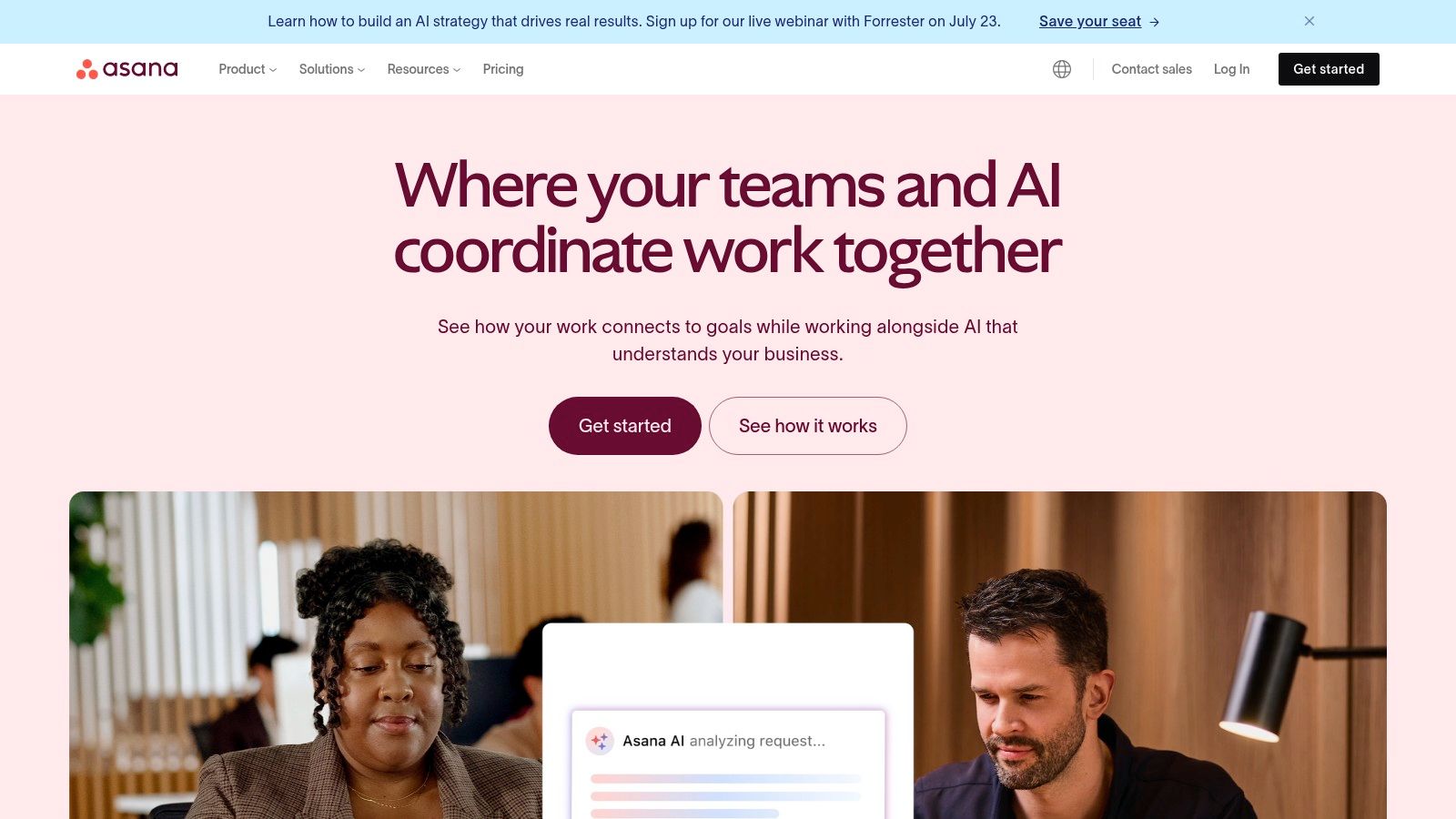
What distinguishes Asana is its flexible viewing options; teams can switch between traditional lists, Kanban-style boards, visual timelines, and calendars to manage work in the format that best suits their process. This adaptability allows it to support diverse creative endeavors, from video production schedules to editorial content calendars. Customizable workflows and robust integration with apps like Adobe Creative Cloud, Slack, and Figma mean it can fit neatly into an existing tech stack, automating communication and reducing administrative overhead. For a deeper look into its capabilities, you can explore more about creative project management software.
Key Considerations
- Best Use Case: Ideal for creative agencies, marketing teams, and content creators managing complex projects with multiple stages and contributors. It excels at tracking progress, assigning tasks, and managing production pipelines.
- User Experience: The interface is clean and user-friendly, although its extensive feature set can feel overwhelming for very simple projects. Onboarding new team members is generally straightforward.
- Pricing & Access: Asana offers a "Basic" free plan for individuals or teams just starting out. Paid plans like "Premium" (starts at $10.99 per user/month) and "Business" (starts at $24.99 per user/month) add features like timelines, advanced reporting, and custom rule builders.
- Limitation: While excellent for managing creative work, Asana is not a tool for doing the creative work itself. Its primary weakness is that it can become overly complex if not configured properly, potentially adding administrative burden to smaller, more agile teams.
Website: https://asana.com/
9. Adobe Creative Cloud
Adobe Creative Cloud stands as the undisputed industry-standard suite for professional creatives, bundling powerhouses like Photoshop, Illustrator, Premiere Pro, and After Effects into a single subscription. While its applications have historically been desktop-focused, Adobe has made significant strides in transforming it into a cohesive ecosystem for creative collaboration. The platform's strength lies in its Creative Cloud Libraries, which allow teams to share assets like colors, graphics, character styles, and brushes seamlessly across all apps and with all collaborators, ensuring brand consistency and streamlining workflows.
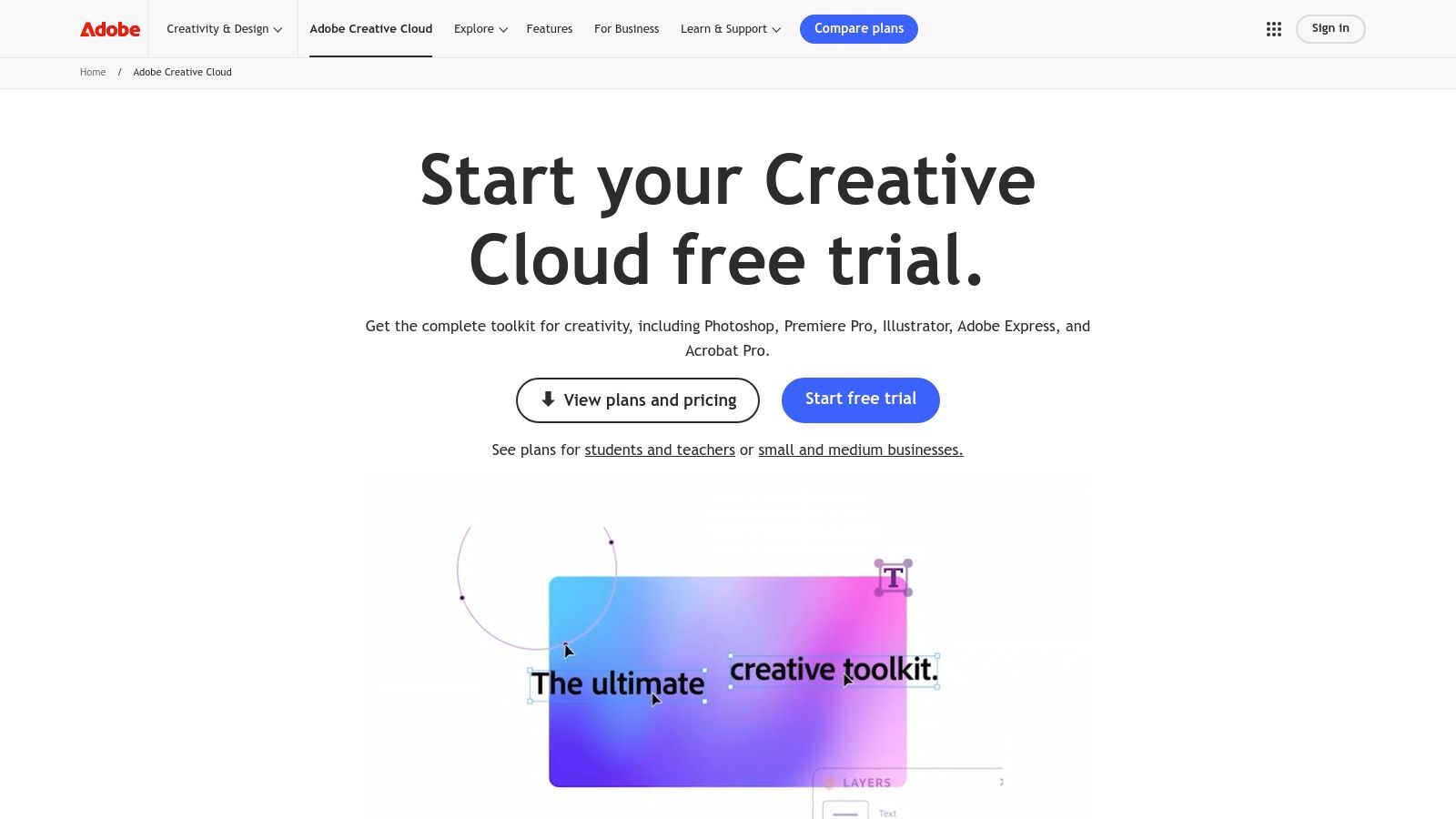
What makes Creative Cloud a cornerstone among creative collaboration tools is the sheer depth and interoperability of its software. A video editor in Premiere Pro can directly use a motion graphic created in After Effects, which in turn uses a vector asset from Illustrator, all kept in sync via the cloud. This integration, combined with cloud storage for easy file sharing and version history, allows for complex, multi-disciplinary projects to be managed within one unified environment. It supports a project from the initial concept in Fresco to final delivery in InDesign without ever leaving the Adobe ecosystem.
Key Considerations
- Best Use Case: Essential for professional creative agencies, production houses, and enterprises that require a comprehensive and powerful suite of tools for graphic design, video editing, web development, and photography.
- User Experience: The individual applications are feature-rich but come with a steep learning curve. While powerful, the sheer number of tools and panels can be overwhelming for beginners. Adobe offers extensive tutorials and resources to mitigate this.
- Pricing & Access: Access is via a subscription model. The "All Apps" plan for individuals costs $59.99/month. Business plans offer enhanced collaboration features like shared asset libraries and start at $89.99/month per license.
- Limitation: The primary drawback is its high subscription cost, which can be prohibitive for freelancers or small businesses. The software is also resource-intensive, requiring powerful hardware for smooth operation, especially for video and 3D work.
Website: https://www.adobe.com/creativecloud.html
10. Slack
While often seen as a general business communication tool, Slack has become the central nervous system for countless creative teams. Its power lies in creating a dedicated, organized space for communication that moves projects forward faster than email ever could. By organizing conversations into specific channels for projects, clients, or creative disciplines, it drastically reduces clutter and keeps discussions focused. This makes it one of the most fundamental creative collaboration tools for coordinating feedback, sharing inspiration, and keeping the entire team aligned.
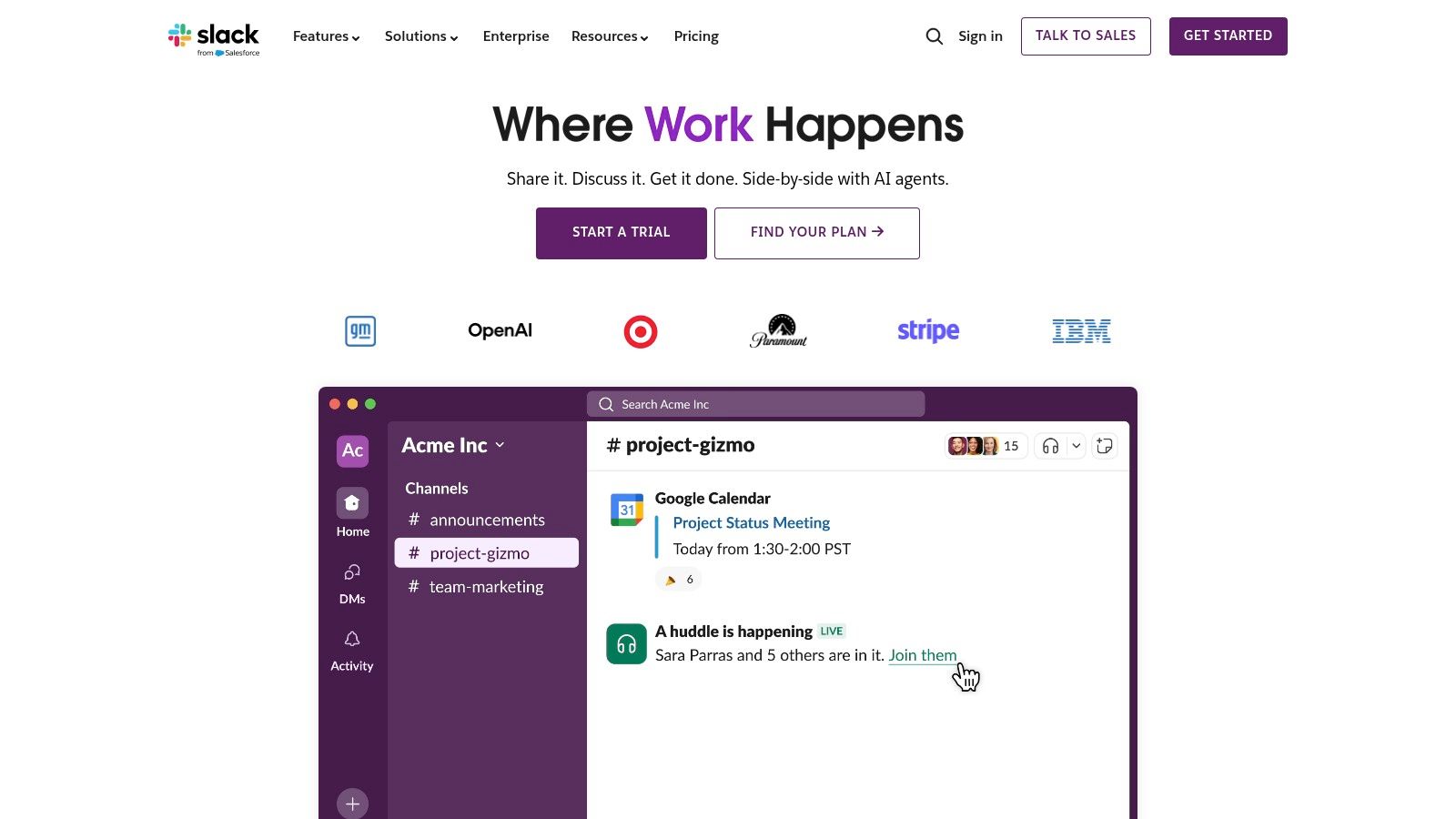
What makes Slack indispensable for creatives is its deep integration ecosystem. Teams can connect it with design tools like Figma or Adobe Creative Cloud to get instant notifications on comments and updates. It also integrates with project management platforms like Asana or Trello, turning conversations directly into actionable tasks. This ability to centralize notifications and file sharing from various other platforms into one searchable hub streamlines creative workflows and minimizes context switching, allowing creators to focus more on their work and less on administrative tracking.
Key Considerations
- Best Use Case: Ideal for creative agencies, marketing departments, and freelance collectives that need a centralized hub for daily communication, file sharing, and project coordination.
- User Experience: The interface is clean, intuitive, and widely adopted, making onboarding new team members seamless. The search functionality is powerful, allowing users to find past conversations or files quickly.
- Pricing & Access: Slack offers a free plan with a 90-day message history limit. Paid plans like "Pro" ($7.25 per user/month) unlock unlimited history and more integrations, while "Business+" ($12.50 per user/month) adds advanced security and compliance features.
- Limitation: The primary drawback is that important conversations can get lost in a sea of channels if not managed properly. The constant notifications can also be a source of distraction if individual settings are not configured to minimize noise.
Website: https://slack.com/
11. Mural
Mural positions itself as a digital-first workspace for visual collaboration, effectively translating the energy of an in-person workshop into a shared online environment. Its strength is its focus on guided, structured brainstorming and planning sessions for distributed teams. The platform provides an infinite canvas where participants can use digital sticky notes, images, and diagrams to map out ideas, create journey maps, or conduct retrospectives. As a dedicated space for ideation, it's one of the most effective creative collaboration tools for turning abstract thoughts into organized, actionable plans.
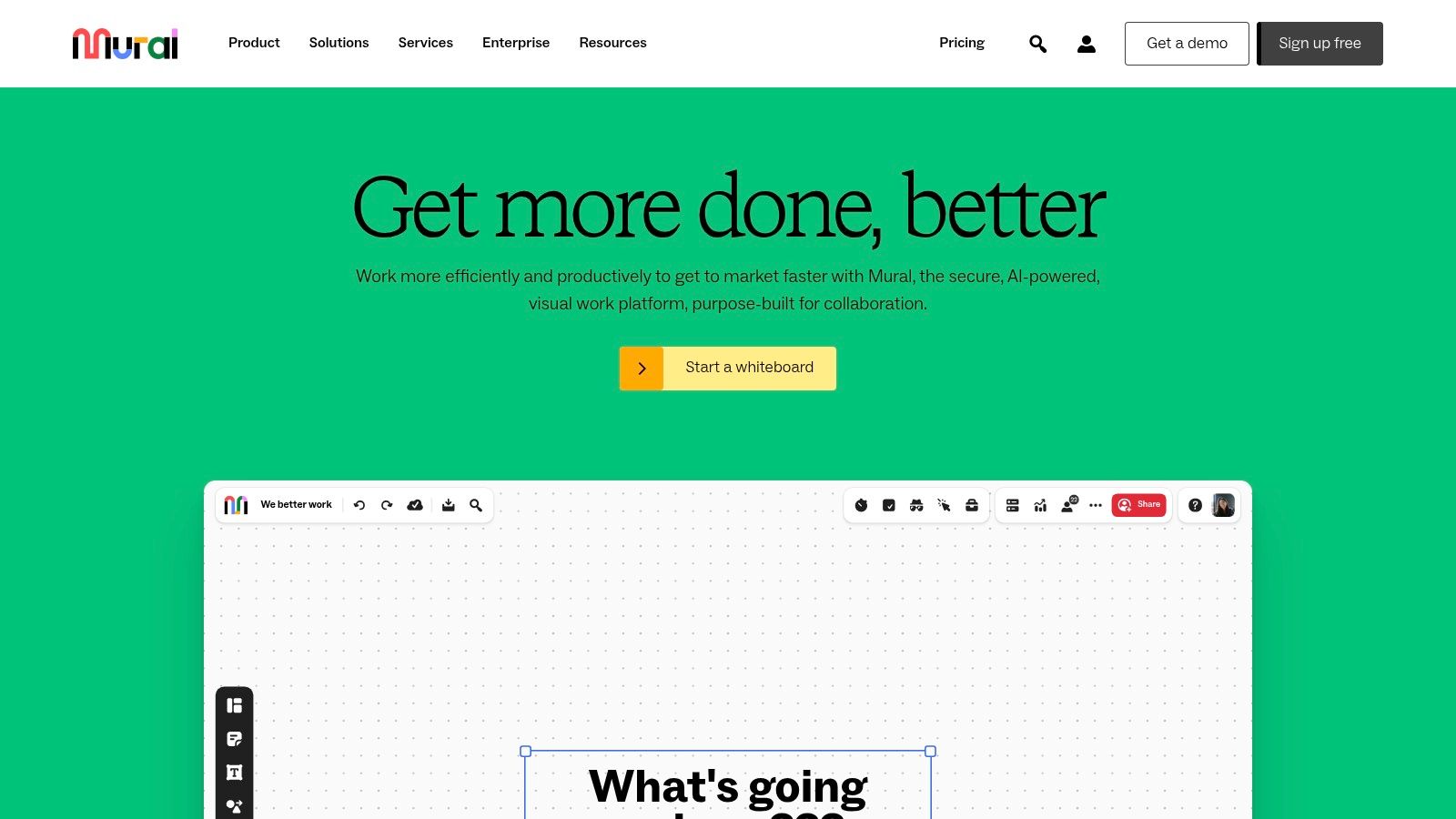
What makes Mural stand out is its emphasis on facilitation. Features like private mode, timers, and a voting system empower facilitators to run engaging and productive remote meetings. An extensive library of pre-built templates for activities like icebreakers, design sprints, and PI planning allows teams to jumpstart their sessions without building frameworks from scratch. This focus on structured facilitation ensures that creative sessions remain focused and inclusive, even with dozens of remote participants.
Key Considerations
- Best Use Case: Excellent for remote or hybrid teams conducting workshops, brainstorming sessions, strategic planning, and agile ceremonies. It is particularly valuable for project managers and workshop facilitators.
- User Experience: The interface is colorful, intuitive, and designed to be user-friendly, encouraging participation from even non-technical team members. Performance can occasionally become sluggish on older hardware or when a mural is populated with a high number of elements.
- Pricing & Access: Mural provides a "Free" plan with access to three murals and all facilitation features for unlimited members. The "Team+" plan is $9.99 per member/month (billed annually), offering unlimited murals. A "Business" plan at $17.99 per member/month adds advanced integrations and reporting.
- Limitation: While versatile, it is not a full-fledged project management or design tool. Its primary function is ideation and visual organization, meaning teams will need to export their work to other platforms like Jira or Figma to execute on the ideas generated.
Website: https://www.mural.co/
12. Zeplin
Zeplin serves as a critical bridge between design and development, functioning as a dedicated workspace for the design handoff process. It ingests designs from tools like Figma or Sketch and translates them into a developer-friendly format, automatically generating technical specifications, assets, and code snippets. This specialized focus makes it one of the most effective creative collaboration tools for ensuring that a visual design is implemented with pixel-perfect accuracy, dramatically reducing back-and-forth communication between teams.
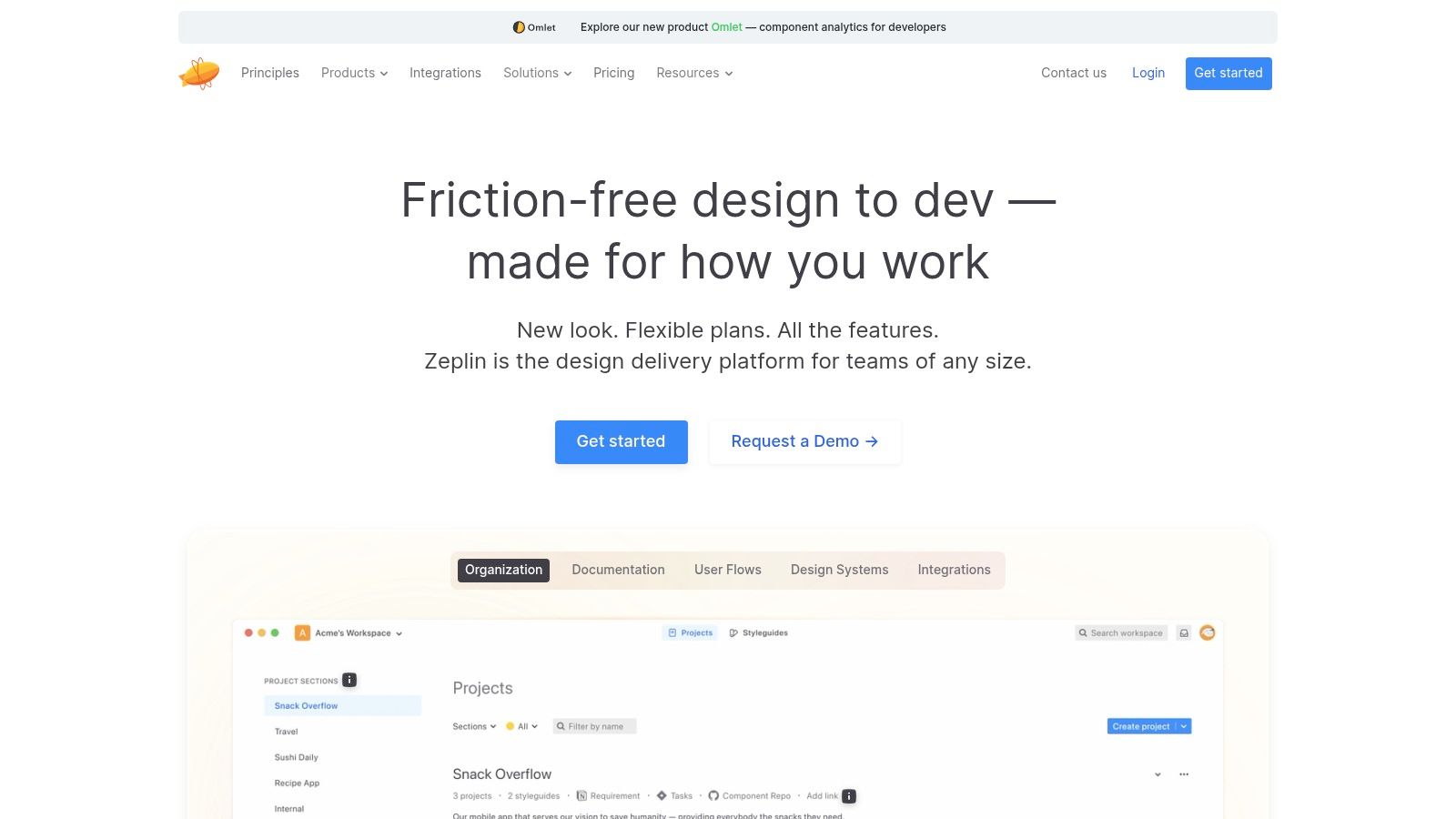
What makes Zeplin stand out is its ability to create a single source of truth for engineering teams. Instead of just viewing a static image, developers can click on any element to get its exact dimensions, colors, typography details, and spacing measurements. The platform also manages assets, allowing developers to download icons and images in the required formats and resolutions for multiple platforms like iOS, Android, and web. This structured environment minimizes ambiguity and empowers developers to work more autonomously.
Key Considerations
- Best Use Case: Essential for product teams, mobile app developers, and web developers who need to translate designs into functional code with precision. It is the ideal tool for the handoff phase of a project.
- User Experience: The interface is clean and purpose-built. It’s highly intuitive for developers who can quickly navigate designs and extract necessary information without needing design software expertise.
- Pricing & Access: Zeplin offers a free plan for a single project. The "Team" plan is $10 per seat/month, and the "Organization" plan is $19 per seat/month, offering unlimited projects, advanced roles, and better security features.
- Limitation: Zeplin's core weakness is its narrow focus. It is not a design tool itself and relies entirely on files imported from other platforms like Figma, Sketch, or Adobe XD. It has limited utility outside the specific design-to-development workflow.
Website: https://zeplin.io/
Creative Collaboration Tools Comparison
| Product | Core Features / Capabilities | User Experience / Quality ★ | Value & Pricing 💰 | Target Audience 👥 | Unique Selling Points ✨ |
|---|---|---|---|---|---|
| 🏆 ai-media-studio | 50+ AI art styles, inpainting/outpainting | ★★★★☆ User-friendly | Free 3 generations/month + tiered plans | Creators, marketers, businesses | Zero design skills needed, full commercial use, strong privacy |
| Figma | Real-time collaboration, prototyping | ★★★★☆ Intuitive, cloud-based | Free & paid; strong community support | UI/UX designers, teams | Interactive prototyping, plugin ecosystem |
| Canva | Drag-and-drop editor, templates, brand kits | ★★★★☆ Easy for beginners | Affordable plans, some premium assets | Beginners, marketers, SMEs | Vast template library, social media focus |
| Miro | Infinite canvas, templates, integrations | ★★★★☆ Highly interactive | Free & paid tiers | Remote teams, project planners | Video chat collab, brainstorming tools |
| InVision | Prototyping, real-time collaboration, testing | ★★★★☆ Efficient feedback | Paid plans; some features premium-only | Product teams, designers | Design-to-dev handoff, user testing |
| Notion | Notes, project mgmt, templates, media embedding | ★★★★☆ Highly flexible | Free & paid; versatile for teams | Individuals, teams | All-in-one customizable workspace |
| Trello | Visual task boards, automation with Butler | ★★★☆☆ Simple, customizable | Free plan with ample features | Small teams, project managers | Drag-drop tasks, easy setup |
| Asana | Task tracking, timelines, workflows | ★★★★☆ Scalable for teams | Free & premium plans | Teams, project managers | Advanced reporting, workflows |
| Adobe Creative Cloud | 20+ apps (Photoshop, Illustrator, etc.) | ★★★★★ Industry standard | Higher subscription cost | Professionals, creatives | Comprehensive toolset, Adobe Stock integration |
| Slack | Channels, messaging, file sharing | ★★★★☆ User-friendly | Free & paid; limited free message history | All team sizes | Extensive integrations, searchable history |
| Mural | Virtual whiteboards, facilitation tools | ★★★★☆ Intuitive collaboration | Free limited plan, paid options | Remote creative teams | Timers, voting, real-time comments |
| Zeplin | Design specs, asset export, version control | ★★★★☆ Streamlines workflows | Paid plans only | Designers, developers | Reduces dev-designer gaps |
Final Thoughts
Navigating the expansive landscape of creative collaboration tools can feel overwhelming, but it's a crucial journey for any team dedicated to producing exceptional work. As we've explored, the "best" tool is rarely a one-size-fits-all solution. Instead, it's a dynamic ecosystem of platforms that, when chosen wisely, can amplify your team's synergy, streamline workflows, and unlock new levels of innovation. From the high-fidelity design handoffs facilitated by Figma and Zeplin to the expansive brainstorming canvases of Miro and Mural, each tool serves a specific, vital function in the creative process.
The core takeaway is that tool selection is a strategic decision, not just an operational one. It requires a deep understanding of your team's unique pain points and project lifecycles. Are you a content creation team struggling with asset management and brand consistency? A platform like Canva for Teams or a robust system like Adobe Creative Cloud might be your anchor. Is your challenge more about organizing complex projects with multiple stakeholders? Then the structured flexibility of Asana or Notion becomes indispensable.
How to Choose Your Perfect Creative Collaboration Stack
Making the right choice involves looking beyond feature lists and focusing on the human element of collaboration. Before committing to a subscription, your team should conduct a thorough internal audit.
- Map Your Current Workflow: Identify every step, from initial brief to final delivery. Pinpoint the exact moments where communication breaks down, feedback gets lost, or bottlenecks occur. This map will reveal the specific problems you need your creative collaboration tools to solve.
- Define Your "Must-Haves" vs. "Nice-to-Haves": Is real-time co-editing non-negotiable? Is a seamless integration with your existing project management software a top priority? Distinguishing between essential features and desirable extras will prevent you from being swayed by bells and whistles you'll never use.
- Consider Your Team's Technical Aptitude: A powerful tool is useless if the learning curve is too steep. Select platforms that align with your team's comfort level. For instance, Trello's simplicity is perfect for teams new to digital project management, while Asana offers a deeper, more complex feature set for seasoned pros.
- Run Pilot Programs: Don't implement a new tool company-wide overnight. Select a small, agile team to test a platform on a real project. Gather honest feedback on its usability, impact on productivity, and integration into the existing workflow. This trial period provides invaluable, real-world data to guide your final decision.
The Future of Creative Collaboration is Integrated and Intelligent
Ultimately, the most effective creative collaboration tools are those that fade into the background, allowing creativity to take center stage. They break down silos, not just between people, but between different phases of the creative process. The ideal setup is an interconnected "stack" where your brainstorming tool (like Miro) seamlessly feeds into your design platform (like Figma), which then syncs with your project manager (like Asana) and communication hub (like Slack).
As technology evolves, we see a clear trend toward more intelligent and automated features, like the generative AI capabilities now being integrated into platforms like Canva and Adobe. These advancements promise to handle mundane tasks, freeing up creators to focus on what they do best: imagining, innovating, and bringing brilliant ideas to life. By thoughtfully selecting and implementing the right set of tools, you are not just buying software; you are building a foundational framework for your team's future success and creative potential.
Ready to unify your entire content creation process with a single, AI-powered platform? ai-media-studio centralizes asset management, AI content generation, and team collaboration to eliminate workflow friction. See how our integrated approach can become the cornerstone of your creative toolkit at ai-media-studio.